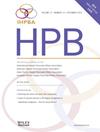Global survey on surgeon preference and current practice for pancreatic neck and body cancer with portomesenteric venous involvement
IF 2.4
3区 医学
Q2 GASTROENTEROLOGY & HEPATOLOGY
引用次数: 0
Abstract
Background
Evidence regarding the optimal surgical approach for pancreatic neck/body cancer with portomesenteric vein (PV) involvement is scarce. We aimed to clarify the current practice using an international survey.
Methods
An online survey was distributed to members of nine international associations and study groups. Surgeons who performed pancreatectomy with PV resection (PVR) in the last 12 months were asked about three clinical scenarios with different PV involvement: scenarios A (<90°; length 1 cm), B (<90°; length 3 cm), and C (90–180°; length 3 cm), with or without common hepatic artery (CHA) involvement. PVR was defined according to the ISGPS definition.
Results
Overall, 222 surgeons from 49 countries in 6 continents completed the survey. The most selected procedures were left pancreatectomy with PVR ISGPS-type 1 for scenario A (52.3 %), PVR ISGPS-type 2 for B (28.8 %), and pancreatoduodenectomy with PVR ISGPS-type 3 for C (28.4 %). In patients with CHA involvement, the most selected procedures were left pancreatectomy without arterial reconstruction for A (57.7 %) and B (50.0 %), and total pancreatectomy for C (29.7 %).
Conclusions
The survey illustrates the heterogeneity in surgical management of pancreatic neck/body cancer with PV involvement, indicating the need for prospective studies and guidelines.
全球调查研究胰腺癌伴肠系膜静脉累及的外科医生偏好和现状。
背景:关于胰颈/体癌伴肠系膜静脉(PV)受累的最佳手术入路的证据很少。我们的目的是通过一项国际调查来澄清目前的做法。方法:对9个国际协会和研究小组的成员进行在线调查。在过去的12个月中,接受胰腺切除术合并PV切除术(PVR)的外科医生被问及三种不同PV累及的临床情况:场景A(结果:总体而言,来自6大洲49个国家的222名外科医生完成了调查。选择最多的手术是左胰切除术,PVR isgps - 1型为A (52.3%), PVR isgps - 2型为B(28.8%),胰十二指肠切除术PVR isgps - 3型为C(28.4%)。在累及CHA的患者中,选择最多的手术是A(57.7%)和B(50.0%)的左胰切除术而不重建动脉,以及C(29.7%)的全胰切除术。结论:该调查显示了胰颈/体癌累及PV的手术治疗的异质性,表明需要前瞻性研究和指南。
本文章由计算机程序翻译,如有差异,请以英文原文为准。
求助全文
约1分钟内获得全文
求助全文
来源期刊

Hpb
GASTROENTEROLOGY & HEPATOLOGY-SURGERY
CiteScore
5.60
自引率
3.40%
发文量
244
审稿时长
57 days
期刊介绍:
HPB is an international forum for clinical, scientific and educational communication.
Twelve issues a year bring the reader leading articles, expert reviews, original articles, images, editorials, and reader correspondence encompassing all aspects of benign and malignant hepatobiliary disease and its management. HPB features relevant aspects of clinical and translational research and practice.
Specific areas of interest include HPB diseases encountered globally by clinical practitioners in this specialist field of gastrointestinal surgery. The journal addresses the challenges faced in the management of cancer involving the liver, biliary system and pancreas. While surgical oncology represents a large part of HPB practice, submission of manuscripts relating to liver and pancreas transplantation, the treatment of benign conditions such as acute and chronic pancreatitis, and those relating to hepatobiliary infection and inflammation are also welcomed. There will be a focus on developing a multidisciplinary approach to diagnosis and treatment with endoscopic and laparoscopic approaches, radiological interventions and surgical techniques being strongly represented. HPB welcomes submission of manuscripts in all these areas and in scientific focused research that has clear clinical relevance to HPB surgical practice.
HPB aims to help its readers - surgeons, physicians, radiologists and basic scientists - to develop their knowledge and practice. HPB will be of interest to specialists involved in the management of hepatobiliary and pancreatic disease however will also inform those working in related fields.
Abstracted and Indexed in:
MEDLINE®
EMBASE
PubMed
Science Citation Index Expanded
Academic Search (EBSCO)
HPB is owned by the International Hepato-Pancreato-Biliary Association (IHPBA) and is also the official Journal of the American Hepato-Pancreato-Biliary Association (AHPBA), the Asian-Pacific Hepato Pancreatic Biliary Association (A-PHPBA) and the European-African Hepato-Pancreatic Biliary Association (E-AHPBA).
 求助内容:
求助内容: 应助结果提醒方式:
应助结果提醒方式:


